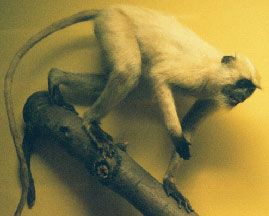Hanumanhanve
hanuman langur (English) [ IPA: hanuman lɑŋˈgʊr ASM: হনুমান লেংগুৰ]
Contributed by: Kulendra Daulagupu on 2009-08-15
hanuman langur (English) [ IPA: hanuman lɑŋˈgʊr ASM: হনুমান লেংগুৰ]
Contributed by: Kulendra Daulagupu on 2009-08-15
1. (Common Noun-Common) A specis of monkey having bristly hairs on the crown and the sides of the face, regarded sacred in India. The hanuman langur is found in the countries of Bangladesh, Bhutan, Burma, China, India, Nepal, and Pakistan. This species is found in a variety of habitats, including scrublands, rainforests, and in cities; the hanuman langur regularly is found in urban areas. The hanuman langur is a folivorous species, but will also consume fruits, flowers, and cultivated crops. In some populations cultivated crops and "hand-outs" from people constitute a large portion of the diet. They can eat the seeds and the fruit from the Strychnos plant which is toxic to humans. This species forages mostly in the early morning and just before nightfall. The hanuman langur is a semi-terrestrial and diurnal species. The hanuman langur moves through the forest and on the ground quadrupedally. The hanuman langur also uses a leaping gait through the forest. The social system of the hanuman langur varies upon location and can be either unimale or multimale-multifemale. Multimale-multifemale troops can have a size up to 125 individuals. In unimale troops the resident male is under constant pressure from other males attempting to take over the troop. When a group of males takes over a troop they will kill the infants and one male will establish himself as the resident male. It has been noted that the new male will mate with the females shortly after takeover. Males may kill infants because they gain a reproductive advantage, this because females will go into estrus shortly after the lose of their infants. Females allow other females to hold and to care for their young (allomothering). All-male troops are found in this species.

